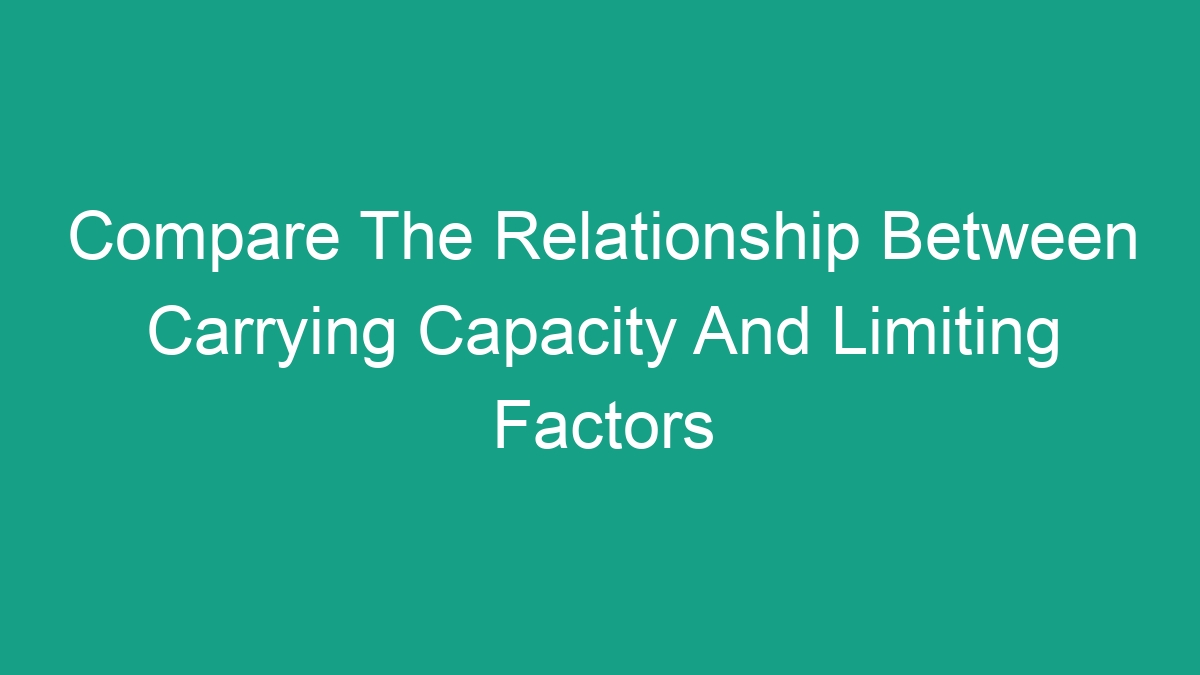
Understanding Carrying Capacity and Limiting Factors
Carrying capacity and limiting factors are two essential concepts in ecology that help us understand how populations of living organisms interact with their environment. Carrying capacity refers to the maximum population size that an environment can sustain indefinitely without degrading the environment, while limiting factors are the environmental factors that determine the carrying capacity of a population.
In this article, we will compare the relationship between carrying capacity and limiting factors, and explore how they influence population dynamics and ecosystem function.
Carrying Capacity
Carrying capacity is a fundamental concept in ecology that is used to describe the maximum population size that a particular environment can support. It is determined by various factors such as food availability, water supply, space, and other resources necessary for the survival and reproduction of a population.
The carrying capacity of an environment is not static and can change over time due to changes in environmental conditions, resource availability, and other factors. When a population exceeds its carrying capacity, it can lead to resource depletion, competition for resources, and ultimately population decline.
Limiting Factors
Limiting factors are the environmental factors that determine the carrying capacity of a population. These factors can be biotic or abiotic and can include factors such as food availability, habitat suitability, predation, disease, and climate. Limiting factors can vary depending on the species and the specific environment.
For example, in a forest ecosystem, food availability, shelter, and space may be limiting factors for a population of deer. In a marine ecosystem, ocean temperature, salinity, and food availability may act as limiting factors for a population of fish.
Comparison of Carrying Capacity and Limiting Factors
The relationship between carrying capacity and limiting factors is complex and interdependent. Limiting factors directly affect the carrying capacity of a population by determining the availability of resources necessary for survival and reproduction. Conversely, the carrying capacity of an environment influences the impact of limiting factors on a population.
When the population size is below the carrying capacity of the environment, the impact of limiting factors may be minimal, and the population may grow rapidly. However, as the population approaches and exceeds the carrying capacity, the impact of limiting factors becomes more significant, leading to increased competition for resources, decreased reproductive success, and higher mortality rates.
Additionally, limiting factors can change over time, influencing the carrying capacity of an environment. For example, climate change can result in shifts in temperature and precipitation patterns, affecting resource availability and habitat suitability for a population. This can lower the carrying capacity of the environment and increase the impact of limiting factors on the population.
Applications in Ecology and Conservation
Understanding the relationship between carrying capacity and limiting factors is essential for ecological research and conservation efforts. By understanding the factors that limit population growth and the carrying capacity of different environments, scientists and conservationists can develop effective management strategies to support healthy and sustainable populations of living organisms.
For example, in wildlife management, understanding the carrying capacity of a particular habitat can help determine sustainable hunting quotas and inform decisions on habitat restoration and protection. Similarly, in agriculture, understanding the carrying capacity of a crop field can help optimize crop yields and minimize environmental impact.
Furthermore, considering the impact of limiting factors on population dynamics and ecosystem function is crucial for biodiversity conservation. By identifying and addressing limiting factors such as habitat destruction, invasive species, and pollution, conservation efforts can help maintain healthy ecosystems and prevent the decline of endangered species.
Conclusion
In conclusion, carrying capacity and limiting factors are critical concepts in ecology that help us understand how populations of living organisms interact with their environment. The relationship between carrying capacity and limiting factors is complex and interdependent, influencing population dynamics and ecosystem function.
By understanding the factors that determine the carrying capacity of different environments and the impact of limiting factors on population growth, we can develop effective management strategies to support sustainable populations and conserve biodiversity. It is essential to continue researching and monitoring the relationship between carrying capacity and limiting factors to inform conservation and management efforts and ensure the long-term health of ecosystems.



